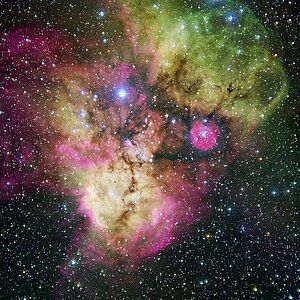NGC 2467
| Emissionsnebel | |
|---|---|
| NGC 2467 | |
 | |
| Aufgenommen mit dem 2,2-m-Teleskop der ESO am La-Silla-Observatorium | |
| AladinLite | |
| Sternbild | Achterdeck des Schiffs |
| Position Äquinoktium: J2000.0, Epoche: J2000.0 | |
| Rektaszension | 07h 52m 23,4s[1] |
| Deklination | -26° 26′ 36″[1] |
| Erscheinungsbild | |
| Scheinbare Helligkeit (visuell) | 7,1 mag[2] |
| Winkelausdehnung | 15,0'[2] |
| Ionisierende Quelle | |
| Physikalische Daten | |
| Zugehörigkeit | Milchstraße |
| Entfernung[3] | 4400 Lj (1355 pc) |
| Geschichte | |
| Entdeckung | William Herschel |
| Datum der Entdeckung | 9. Dezember 1784 |
| Katalogbezeichnungen | |
| NGC 2467 • OCL 668 • ESO 493-SC25 • LBN 1065 • Cr 164 • H IV 22 • GC 1589 | |
NGC 2467 ist ein noch junger offener Sternhaufen im südlichen Sternbild Puppis (Achterschiff). Er hat eine Winkelausdehnung von 15,0′ und eine scheinbare Helligkeit von 7,1 mag. Der Sternhaufen ist etwa 4500 Lichtjahre vom Sonnensystem entfernt.
Der Sternhaufen befindet sich noch in einem Kokon aus Gas und Staub, in dem seine Sterne entstanden sind. Diese massereichen Sterne sind so heiß, dass sie überwiegend im ultravioletten und kurzwelligen blauen Licht strahlen. Die energiereiche Strahlung regt den sie umgebenden Wasserstoff zum Leuchten an, mit der rötlichen H-alpha-Strahlung, die im Bild oben zu sehen ist. Aus diesem Grund werden solche Gaswolken auch H-alpha- oder Emissionsnebel genannt.[4]
Das Objekt wurde am 9. Dezember 1784 von William Herschel entdeckt.[5]

Weblinks
- Ein Gespenst am Südhimmel. eso1834 – Bildveröffentlichung, 17. Oktober 2018
- The Cosmic Christmas Ghost. eso0544 — Bildveröffentlichung, 25. Dezember 2005
- Jungsterne in NGC 2467. spektrum.de, 14. Juli 2010
- Bild des Tages. astronews.com, 20. August 2013
- Bild des Tages. astronews.com, 19. April 2013
Einzelnachweise
Auf dieser Seite verwendete Medien
Autor/Urheber: ESO, Lizenz: CC BY 4.0
Area surrounding the stellar cluster NGC 2467, located in the southern constellation of Puppis ("The Stern"). With an age of a few million years at most, it is a very active stellar nursery, where new stars are born continuously from large clouds of dust and gas. The image, looking like a colourful cosmic ghost or a gigantic celestial Mandrill, contains the open clusters Haffner 18 (annotated in Commons, centre) and Haffner 19 (annotated, middle right: it is located inside the smaller pink region — the lower eye of the Mandrill), as well as vast areas of ionised gas. The bright star at the centre of the largest pink region on the bottom of the image is HD 64315, a massive young star that is helping shaping the structure of the whole nebular region. HD 64568 (annotated, upper right) is a hot, extremely massive main sequence blue-white star that is the prototype of the O3 V((f*)) spectral category.
In the center of this image, the open stellar cluster Haffner 18 illustrates three different stages of this process of star formation: In the centre of the annotated area, a group of mature stars that have already dispersed their birth nebulae represents the completed product or immediate past of the star-formation process. Towards the top left of the annotated area, a very young star, FM3060a, just come into existence and still surrounded by its birth cocoon of gas, provides insight into the earliest moments of star birth. Finally, the dust clouds towards the bottom left corner of the annotated area are active stellar nurseries that will produce more new stars in the future. [1]
This image of NGC 2467 is based on 49 images in six different filters obtained in December 2003 with the Wide-Field Imager camera at the 2.2m MPG/ESO telescope, located at La Silla, in Chile. North is right and East is to the top. Bright red denotes the H-alpha line. Green denotes the green emission lines of doubly ionized oxygen OIII.
NGC 2467 open cluster and emission nebula by Hubble Space Telescope; 3.2′ view

